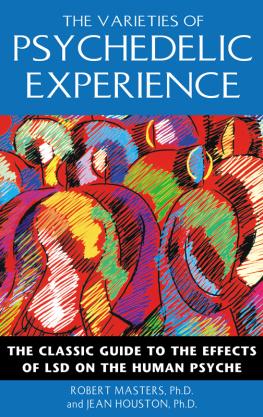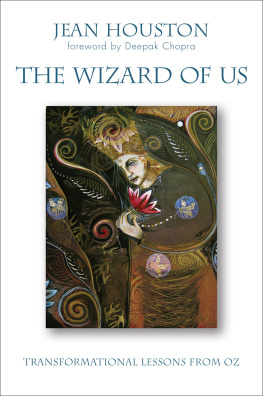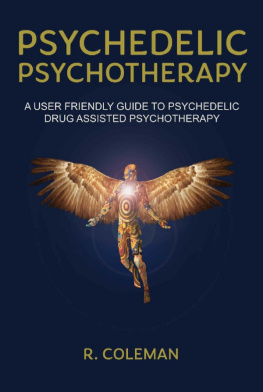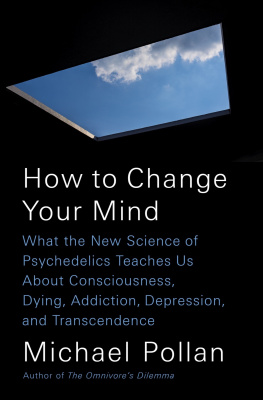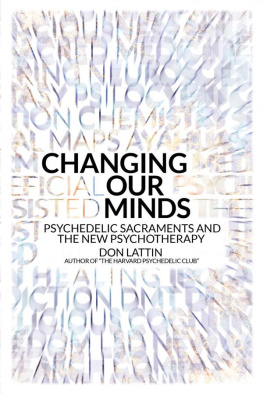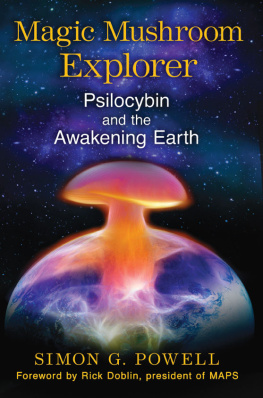THE VARIETIES OF
PSYCHEDELIC EXPERIENCE
THE CLASSIC GUIDE TO THE EFFECTS OF LSD ON THE HUMAN PSYCHE
ROBERT MASTERS, Ph.D. and JEAN HOUSTON, Ph.D.

Park Street Press
Rochester, Vermont
For Our Parents
| Katherine Masters | Mary Houston |
| Col. Robert Masters | Jack Houston |
Preface
Almost thirty-five years have passed since The Varieties of Psychedelic Experience was first published. Jean and I wrote it together during the months just after we were married and, unlike a great many book collaborations, we were almost completely in agreement about what we would say and how we wanted to say it. The collaboration was further enhanced by a tiny and immensely devoted Siamese cat named Psychedelic who sat on my right shoulder while I was typing and seemed to purr and occasionally to tread when I was making my best points.
We had each been involved in research with psychedelics for quite a few years before writing the bookmy work beginning in 1954at first working independently, then working together as a research team. It was of great interest to discover that many of the observations each of us had made working independently were very similar or even identical.
The so-called Drug War was unheard of in those days and there was great excitement and often enthusiasm surrounding the work with psychedelics, especially LSD-25. Thousands of papers had been published in scientific journals describing psychotherapeutic and other work with LSD. Although Timothy Leary and a few other self-anointed messiahs were already generating some opposition, in general the public mind at least remained open concerning the value of psychedelic research. The Drug War would all but destroy that open-mindedness, and even criminalize work with psychedelics, but it had not yet done so and many agreed with us that LSD and some similar substances provided unparalleled access to a great variety of mental processes and to the personal unconscious with its rich images and many other treasures. Some agreed that this included openings also into the collective unconscious and into dimensions where access usually is given only to those who achieve it by means of deep, intense, and prolonged psychophysical and psychospiritual disciplines.
Shortly after Varieties was published we picked up a copy of the Sunday New York Times and found to our delight that we had been given the front page of the New York Times Book Reviewsomething that almost guaranteed many other book reviews and a substantial audience for the book. The review was written by a psychiatrist not altogether friendly to LSD research and he described the book as offering a whole new system of psychopathology. He mostly praised the book as a serious and important study but generally hewed to the line that the psychedelic experience was pathological. That view, which has been espoused by most psychiatrists who first worked with LSD, had been abandoned by many at the time. The label psychotomimetic (mimicking a psychosis) had already largely been replaced by the term psychedelic (mind-manifesting), which was proposed by the distinguished British psychiatrist Humphry Osmond after he collaborated with Aldous Huxley on a term that could gain widespread acceptance while escaping negative meanings.
The Varieties of Psychedelic Experience was in fact very widely and favorably reviewed in many different kinds of publications, including scientific ones, and in many countries. Besides making the book well-known, these reviews had the effect of bringing to the door of our New York City apartment quite a large number of interesting and diverse visitors. They included a spectrum of psychotherapists, scientists of various sorts, philosophers, theologians, psychiatrists, other physicians and psychologists, swamis of yoga and Tibetan lamas, Zen Buddhists and Sufis, anthropologists, authors and artists, and even an occasional offer of funding for new research. Clearly the interest in psychedelics was worldwide and included a host of exceptionally intelligent and learned people from many different occupations and areas of interest. In the case of the artists, a movement of sorts was being born and we eventually described it in another book, Psychedelic Art.
SOME CONCLUSIONS AND RECOMMENDATIONS
It has been said of the ancient Persians that when they had some matter of real importance to consider they went over it once while sober and a second time while in an intoxicated state. Then they made their decision based on the best thinking and understandings gleaned from the two approaches. If a matter was important, they felt, it should not be examined solely by means of ordinary states of consciousness.
Herodotus, who speaks of this, does not say just what kind of intoxicant was used. It could have been alcohol, since there are many ways of using that substance which are little if at all known to people at present. The ancient religious uses, for example, call attention once again to the extreme importance of set and setting. But the Persians might have used some other substance to achieve their altered or intoxicated states of consciousness.
In The Varieties of Psychedelic Experience we wrote that psychedelics such as LSD afford the best access yet to the contents and processes of the human mind. Removed now from that conclusion by more than three decades, I find no reason to alter it. And I would add that there is an enormous range of valuable applications of psychedelics which has not been explored because of our societys failure to recognize the constructive possibilities. As matters stand, it well may occur that all of those persons who became experienced in the very complicated work with psychedelics will die of old age before our society gains enough maturity and wisdom to let the work proceed. Alas, very few understand the magnitude of that loss.
When it finally happens that psychedelic researchleft sufficiently free to realize the potentialsis permitted, then that freedom must include an agreement that under no circumstances must it be monopolized by psychiatrists. Psychologists, philosophers, theologians, anthropologists, artists, scientists, engineersthose from many different disciplines and fieldsmust be allowed to contribute to the body of knowledge that will be generated. Given the range and diversity of the psychedelic experienceand truly nothing human is alien to itinvestigation must be multidisciplinary if it is not to be warped and stunted. And we must understand and agree that some of this work will be exploration, not subject to the kinds of constraints imposed if it were to be more narrowly defined.
I will mention just a few areas where work with psychedelics seems to me to be most promising. These include research into the levels and dimensions of consciousness; psychotherapy; creative process and problem-solving; neural and sensory reeducation; nature and regulation of pain; enhancement of pleasure, including sexual pleasure; expanded awareness of self and world, including aesthetic appreciation; paranormal capacities; exploration of the worlds of myth and religion; and the pursuit of self-knowledge and personal growth, including perhaps some sanctioned rites of passage.
Psychotherapy. Few people now remember that by 1965 there had appeared in scientific journals well over two thousand papers describing treatment of thirty to forty thousand patients with psychedelics. There were additional reports from hundreds of psychotherapists working in many of the countries and cultures of the world, and therapy with psychedelics continued to proliferate on into the 1970s, up to the time when prohibited. Many different kinds of patients were successfully treated, often in just a few sessions, includingironicallyalcohol and other drug addicts, along with habitual criminals, sexual deviates, violence-prone individuals, and people suffering from chronic anxiety states, depression, and many other disorders of the kinds with which therapists frequently must deal.
Next page
